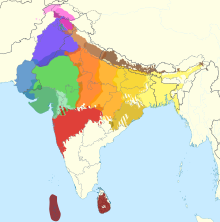Eastern Indo-Aryan languages
| Eastern Indo-Aryan | |
|---|---|
| Magadhan | |
| Geographic distribution | Eastern India, Bangladesh, southern Nepal |
| Linguistic classification | Indo-European
|
Early forms | |
| Subdivisions | |
| Language codes | |
| Glottolog | indo1323 (Indo-Aryan Eastern zone)biha1245 (Bihari) |

The Eastern Indo-Aryan languages, also known as Māgadhan languages, are spoken throughout the eastern region of the Indian subcontinent, which includes Bihar, Uttar Pradesh, Jharkhand, Bengal region, Tripura, Assam, and Odisha; alongside other regions surrounding the northeastern Himalayan corridor. Bengali is official language of Bangladesh and the state of West Bengal, Tripura and the Barak valley of Assam while Assamese and Odia are the official languages of Assam and Odisha, respectively. The Eastern Indo-Aryan languages descend from Abahattha, which descends from Magadhan Apabhraṃśa[1] and ultimately from Magadhi Prakrit.[2][3][1]
Classification
[edit]The exact scope of the Eastern branch of the Indo-Aryan languages is controversial. All scholars agree about a kernel that includes the Odia cluster and the Bengali–Assamese languages, while many also include the Bihari languages. The widest scope was proposed by Suniti Kumar Chatterji who included the Eastern Hindi varieties, but this has not been widely accepted.[4]
When the Bihari languages are included, the Eastern Indo-Aryan languages fall into four language groups in two broader categories:[citation needed]
Western Magadhan
[edit]- Bihari
- Bhojpuri
- Magahi
- Maithili
- Sadanic
- Unclassified Bihari
- Tharuic
- Chitwania Tharu
- Dangaura Tharu
- Dangaha
- Sonha
- Kathariya Tharu
- Kochila Tharu
- Western Kochila
- Central Kochila (Saptariya Tharu)
- Eastern Kochila (Morangiya, Khawas Tharu)
- Rana Tharu
- Buksa
- Musasa
- Majhi
- Kumhali
- Kuswaric
- Danwar
- Dewas Done Danuwar
- Dewas Rai
- Done Danuwar
- Kochariya-East Danuwar
- East Danuwar
- Kochariya
- Dewas Done Danuwar
- Bote-Darai
- Bote
- Darai
- Danwar
- Tharuic
Eastern Magadhan
[edit]- Bengali–Assamese:
- Bengali
- Bangali (Eastern Bengali)
- Chittagonian
- Noakhailla
- Sundarbani (Southern Bengali)
- Sylheti
- Bishnupriya Manipuri
- Chakma
- Manbhumi (Western Bengali)
- Rarhi (South-Central Bengali)
- Rohingya
- Tanchangya
- Varendri (North-Central Bengali)
- Bangali (Eastern Bengali)
- Kamarupic:
- Eastern Kamarupi
- Assamese
- Eastern
- Central
- Kamrupi (Western Assamese)
- Goalpariya (Western Assamese)
- Assamese
- Western Kamarupi
- Eastern Kamarupi
- Bengali
- Odia languages
- Odia Family
- Baleswari (Northern Odia)
- Singhbhumi(Southern Jharkhand)
- Kataki (Central Odia)
- Sambalpuri (Western Odia)
- Sundargadi (Northwestern Odia)
- Kalahandia (Southwestern Odia)
- Desia (Koraputia Odia)
- Ganjami (Southern Odia)
- Bodo Parja
- Bhatri
- Reli
- Kupia
- Odia Family
- Halbic:
Features
[edit]Grammatical features of the Eastern Indo-Aryan languages:[5]
| Case | Bengali | Assamese | Odia | Rajbangshi | Surjapuri | Maithili | Bhojpuri | Tharu | Sylheti |
|---|---|---|---|---|---|---|---|---|---|
| Instrumental | -t̪e, -ke d̪ie | -e, -er-e, di, -e-di | -e, -re, -d̪ei | -d̪i | sɛ | -e,e˜, sə˜, d̪ea | le, leka | -re, di | |
| Dative | -ke, -[e]re | -k, -ɒk | -ku | -k, -ɔk | -k, -ɔk | -ke˜ | -ke | -hənə | -gu, -gur |
| Ablative | -t̪ʰeke | -pɒra | -u, -ru, -ʈʰaru, -ʈʰiru | -hat̪ɛ, t̪ʰaki | -sɛ | -sə˜, -k -karəne | se | -lagi, -tône | |
| Genitive | -r, -er | -r, -ɒr | -rɔ | -r, -ɛr | -r, -ɛr | -ker (-k) | -kæ | -ək | -r, -ôr |
| Locative | -e, -t̪e | -t, -ɒt | -re | -t̪, -ɔt̪ | -t̪, -ɔt̪ | e, me, -hi, -tə | -mə | -t, -ô |
Eastern Indo-Aryan languages display many morphosyntactic features similar to those of Munda languages, while western Indo-Aryan languages do not. It is suggested that "pre-Munda" ("proto-" in regular terminology) languages may have once dominated the eastern Indo-Gangetic Plain, and were then absorbed by Indo-Aryan languages at an early date as Indo-Aryan spread east.[6][7]
References
[edit]- ^ a b Ray, Tapas S. (2007). "Chapter Eleven: "Oriya". In Jain, Danesh; Cardona, George. The Indo-Aryan Languages. Routledge. p. 445. ISBN 978-1-135-79711-9.
- ^ Cardona, George; Jain, Dhanesh, eds. (2003), "The historical context and development of Indo-Aryan", The Indo-Aryan Languages, Routledge language family series, London: Routledge, pp. 46–66, ISBN 0-7007-1130-9
- ^ South Asian folklore: an encyclopedia : Afghanistan, Bangladesh, India, By Peter J. Claus, Sarah Diamond, Margaret Ann Mills, Routledge, 2003, p. 203
- ^ Masica, Colin (1991). The Indo-Aryan Languages. Cambridge: Cambridge University Press. pp. 446–462.
- ^ (Toulmin 2006:148)
- ^ Peterson, John (2017). "The prehistorical spread of Austro-Asiatic in South Asia Archived 11 April 2018 at the Wayback Machine". Presented at ICAAL 7, Kiel, Germany.
- ^ Ivani, Jessica K.; Paudyal, Netra; Peterson, John (2020-09-01). "Indo-Aryan – a house divided? Evidence for the east–west Indo-Aryan divide and its significance for the study of northern South Asia". Journal of South Asian Languages and Linguistics. 7 (2): 287–326. doi:10.1515/jsall-2021-2029. ISSN 2196-078X.
External links
[edit]- A Comparative dictionary of the Bihārī language, Volume 1 By August Friedrich Rudolf Hoernle, Sir George Abraham Grierson (1885)
- Toulmin, Mathew W S (2006). Reconstructing linguistic history in a dialect continuum: The Kamta, Rajbanshi, and Northern Deshi Bangla subgroup of Indo-Aryan (PhD). The Australian National University.
